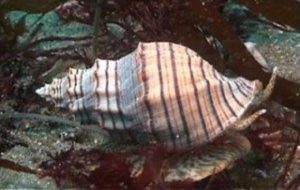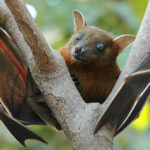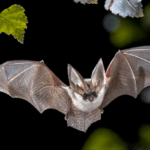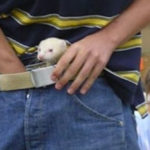 Mysteries
Mysteries  Mysteries
Mysteries  History
History 10 Surprising Stories About the Texas Rangers
 Humans
Humans 10 Philosophers Who Were Driven Mad by Their Own Theories
 Miscellaneous
Miscellaneous 10 Video-Game-Worthy Weapons and Armors from History
 Weird Stuff
Weird Stuff 10 Psychics Who Accurately Predicted Wartime Events
 The Arts
The Arts 10 Pieces of Art Inspired by a Broken Heart
 Health
Health 10 Science Fiction-Sounding New Medical Treatments
 History
History 10 Surprising Facts About the Father of Submarine Warfare
 Space
Space Ten Astonishing New Insights into Alien Worlds
 Weird Stuff
Weird Stuff 10 Bizarre Summer Solstice Rituals Still Practiced Today
 Mysteries
Mysteries Top 10 Haunting Facts About the Ghost Ship MV Alta
 History
History 10 Surprising Stories About the Texas Rangers
 Humans
Humans 10 Philosophers Who Were Driven Mad by Their Own Theories
Who's Behind Listverse?

Jamie Frater
Head Editor
Jamie founded Listverse due to an insatiable desire to share fascinating, obscure, and bizarre facts. He has been a guest speaker on numerous national radio and television stations and is a five time published author.
More About Us Miscellaneous
Miscellaneous 10 Video-Game-Worthy Weapons and Armors from History
 Weird Stuff
Weird Stuff 10 Psychics Who Accurately Predicted Wartime Events
 The Arts
The Arts 10 Pieces of Art Inspired by a Broken Heart
 Health
Health 10 Science Fiction-Sounding New Medical Treatments
 History
History 10 Surprising Facts About the Father of Submarine Warfare
 Space
Space Ten Astonishing New Insights into Alien Worlds
 Weird Stuff
Weird Stuff 10 Bizarre Summer Solstice Rituals Still Practiced Today
10 Animals with a Taste for Blood
If you have been on the internet in the past few months, you have probably seen the horror stories of bedbug infestations. These little bloodsuckers invade a house and scurry away into every corner of your home before coming out at night to slurp up your blood. Reading about them is enough to make your skin crawl without knowing how hard they are to eradicate.
But blood drinking is not limited to bedbugs. The natural world is full of animals that are happy to siphon off their prey’s blood for a nutritious and tasty meal. Here are ten other animals with a hunger for blood.
Related: Top 10 Weirder and Kinkier Things Bats Do Than Sucking Blood
10 Vampire Bat
One of the most famous hematophages—blood eaters—of the animal kingdom is the vampire bat of Central and South America. Three closely related species of these bats live exclusively on blood that they take from vertebrate prey. How they do this is both clever and creepy.
The bats have numerous adaptations that allow them to get away with their blood theft without detection. Instead of swooping down from the air and attracting attention, they creep along the ground in the night and hop up onto the animal that they have located with special heat sensors in their nose. Then, they cling to the animal and use exceptionally sharp teeth to shave away any hair at their target site. These teeth lack enamel and are much better at cutting than other mammal teeth. Then, a tiny incision is made in the skin for the blood to escape from the host.
Don’t worry, though—you won’t feel a thing. The bite is apparently painless, possibly because of some anesthetic compound in the bat’s saliva. This also contains a protein called, with literary humor, Draculin that stops the blood from clotting so that the bat can feed uninterrupted for up to 30 minutes. While most vampire bats target horses, cattle, goats, and birds, there have been reports of sleeping humans providing a warm meal.[1]
9 Lamprey
Lampreys are strange-looking fish with an unusual lifecycle. Many of them hatch from their eggs as almost blind larvae and burrow into soft sand. There they spend years sucking floating detritus out of the water and growing slowly. After several years, they emerge as fully formed adults. In some species, the adults never feed and use nutrient reserves they acquired as larvae to support them in their hunt for a mate. Some species, however, do feed. And they have a hunger for blood.
This hunger has been present in lampreys since the Jurassic Era, so they have had plenty of time to perfect their hunting technique. The lamprey’s mouth is a sucking funnel filled with radiating rows of teeth. The lampreys use their mouths to latch onto other fish and rasp their way into its flesh. They then suck the blood straight from their prey, leaving large scars behind.
For some reason, as yet unknown, lampreys have the largest number of chromosomes of a vertebrate species, with some having as many as 174.[2]
8 Kissing Bugs
While most blood-sucking animals are named after vampires—for obvious reasons—somehow, these animals got named the cute-sounding kissing bugs. While bedbugs get much of the attention when it comes to vampiric insects, at least they have the mercy of being small. Kissing bugs can be up to an inch long (2.54 cm). One of the first European reports of kissing bugs feeding on a human came from Charles Darwin when he described “an attack (for it deserves no less a name).” He studied how the insects fed and noticed them running toward any finger placed on a table.
The kissing bugs swell enormously as they suck the blood from their prey. They can take on more than twelve times their own body weight during a single meal. Where do they strike? They like to find sleeping mammals and aim for the thin skin near the eyes and mouth, but any skin is a goal.
For most people, the attack goes unnoticed, but it can have catastrophic effects. As the insect becomes bloated on blood, its urine and feces are forced out by the pressure. These can be laced with the organisms that cause Chagas disease. If these get into the host’s body, then they cause heart damage and even death.[3]
7 Oxpecker
Sometimes in nature, you will find sweet interactions between two species that offer benefits to both partners. These mutualistic interactions are sometimes anthropomorphized as animal friendships. When it comes to the oxpecker bird and the large mammals it visits, the relationship is anything but cordial.
The oxpeckers live in Africa and, as their name suggests, can be seen pecking at oxen, rhinos, zebras, giraffes, and hippopotami. In Swahili, their name means “Rhino guard.” For a long time it was thought that the birds were simply helping the other animals by feeding on ticks and other parasites that live on them.
Then, it was seen that sometimes, the birds deliberately inflict wounds on the larger animals and open up old ones. Once this is done, the birds dip their beaks into the flesh and slurp up a little blood. It’s not just their blood that the animals visited by oxpeckers have to watch out for. The birds will also consume loose flakes of skin and earwax.[4]
6 Horse Flies
Horse flies are beneficial creatures to many plant species. They like to lap up nectar from flowers, and while they do so, they help pollinate them by carrying pollen from plant to plant. But when it comes time to breed, the females have to look for a more exotic drink.
The mouthparts of female horse flies are specially adapted to feeding through vertebrate skin. Attached to their mouths are viciously sharp stylets. When the horse fly lands on its prey, it latches on tightly and then thrusts its head forward to pierce the skin. Then it gets to work by moving the stylets back and forth to make a wound. As the blood wells up, they sponge up the liquid and swallow it. The female horse fly needs to drink blood as the nutrients are necessary to develop their eggs.
While some blood-drinking animals have the courtesy to inject an anesthetic when they eat to make for a painless process, horse flies do not bother. Their bites can be very itchy and hurt long after the fly is off to start its family.[5]
5 Cooper’s Nutmeg

Sea snails are generally only notable to most people for their intricate and often beautiful shells. Most of them get their food by grazing on the algae coating the rocks under the sea or munching on seaweed, barnacles, and other mollusks. Cooper’s nutmeg, Cancellaria cooperii, a snail that lives off the west coast of the United States, prefers a richer diet.
Cooper’s nutmeg approaches electric ray fish as they rest on the ocean floor. The mollusks seemingly have a taste for danger. These fish can produce powerful electrical pulses to stun prey and ward off predators. Once within reach, the snail projects its proboscis toward the fish and makes a small cut with its teeth before sucking up the blood.
The snails seem only to target a single species of ray, and when they find one, up to twelve have been observed attacking a single fish. They have been seen biting open wounds, the skin, gills, and anuses of the electric rays.[6]
4 Candiru
The piranha may be the most feared fish in the Amazon River, but its reputation as an eater of humans and other large mammals has been exaggerated. Many eat fruits, seeds, and detritus, as well as other animals. The candiru, however, does only target other animals.
The candiru is a fish that parasitizes catfish in the Amazon. They can sense the urea that the fish release through their gills. Once this is detected, they home in on the fish and dart into their gills. The candiru then uses spikes on its head to latch on. The candiru pierces the arteries in the gills, and the fish’s own blood pressure forces the blood into the parasite. After only a couple of minutes, the candiru is full and swims away.
There have long been rumors that human men are at risk from attack by candiru when they urinate in the Amazon. Apparently, the candiru mistakes the warmth and urine for a fish and swims straight into the urethra, where it lodges with its spikes. Perhaps fortunately, there are no confirmed cases where this has actually happened.[7]
3 Evarcha culicivora
Mosquitoes are among the deadliest foes of humanity and are, of course, bloodsuckers. They spread a number of deadly diseases as they go around targeting people. Once they have stolen human blood, however, the mosquitoes themselves become the target of yet another blood-hungry creature.
The jumping spider Evarcha culicivora that lives around Lake Victoria in Africa has a taste for mosquitoes that have recently bitten a mammal. The spiders enjoy eating nectar from plants, but when they sense a glutted mosquito, they move in for the kill. Laboratory tests have shown that spiders use both smell and sight to distinguish between mosquitoes that have recently eaten and those that have no blood in them.
Some researchers think that these spiders could be a valuable ally in the fight against mosquitoes and the diseases they carry.[8]
2 Vampire Moths
Moths and butterflies are usually thought of as just pretty insects that flit around, spreading happiness. But any animal can have an unnerving diet. Some butterflies are known to drink tears. And some moths have a liking for animal blood.
The moth Calyptra thalictra that lives across Asia is one such moth. They usually use their proboscis to pierce the skin of fruit to suck out the sweet fluids within. However, the males of the species will occasionally target mammals—including humans. They do not have mouth parts well adapted to this, so feeding on blood is somewhat difficult for them. The male lands on its prey and has to rock back and forth roughly to work the tip of its proboscis through the skin. Once inside, it draws blood up and into their stomach.
It is hypothesized that the males do this to get nutrients that they can pass to the females with their sperm to help the young develop.[9]
1 Vampire Ground Finch
Charles Darwin famously studied the adaptations of the finches on the Galapagos Islands and began to find evidence for his theory of evolution. He never saw the vampire ground finch, though, or he might have had some things to say.
The vampire ground finches have sharp beaks that they use to consume fruit and insects on their islands. When there is a scarcity of their usual food, the birds live up to their name. The small finches move toward the nesting grounds of larger birds like boobies and target their tails. With lots of pecking, the finches break the skin and begin to lap up the fluid that flows from the boobies. The larger birds sometimes put up some resistance to this and scare the finches off but often simply allow the finches to eat.
The finches do not just target adult birds. When hungry, the finches attack other birds’ nests to steal the eggs by rolling them away, cracking them open, and feasting on what’s within.[10]








